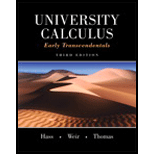
In Exercises 1−16, make the given substitutions to evaluate the indefinite
1.
Learn your wayIncludes step-by-step video

Chapter 5 Solutions
University Calculus: Early Transcendentals (3rd Edition)
Additional Math Textbook Solutions
Glencoe Math Accelerated, Student Edition
Calculus: Early Transcendentals (3rd Edition)
Precalculus (10th Edition)
Precalculus
- Agree or disagree with the statement: the integral 十3 dx can be x²+16 computed by 4 different methods. If you agree, state which methods. If you disagree, explain (with mathematical reasons) why you disagree.arrow_forward4. Find the indefinite integrals. What should u be? a. (2x+6)³ dx · √ (3x² − 1)ex³-xdx - 1 b. / 3x²+ 5 dx 10x3 - 5x d. √√x4 - x² +6 dxarrow_forward17) Calculate the indefinite integral S= 5dx √4-16x² 16) Evaluate the definite integral. 3 1716x² O Šth dxarrow_forward
- Evaluate +1+ x2 dx. (1+ x²)² Hint: Write this as two "easy" integrals. You do not need u-substitution or integration by-parts. 1arrow_forwardEvaluate the following definite and indefinite integrals. V6 (a) da V3+1 (b) / da V3 – r2 (c) x* +x + 18 dr Your final answer can be a decimal rounded to 2 decimal places. r(3+ x2) (6x + 2x*) sec (3+ x²) dx Hint: Do some factoring first.arrow_forwardUse substitution to find the indefinite integral. 6x +5 xp- 3 (9x² + 15x) ** 6x +5 3 (9x? +1 + 15x)arrow_forward
- Algebra & Trigonometry with Analytic GeometryAlgebraISBN:9781133382119Author:SwokowskiPublisher:Cengage
